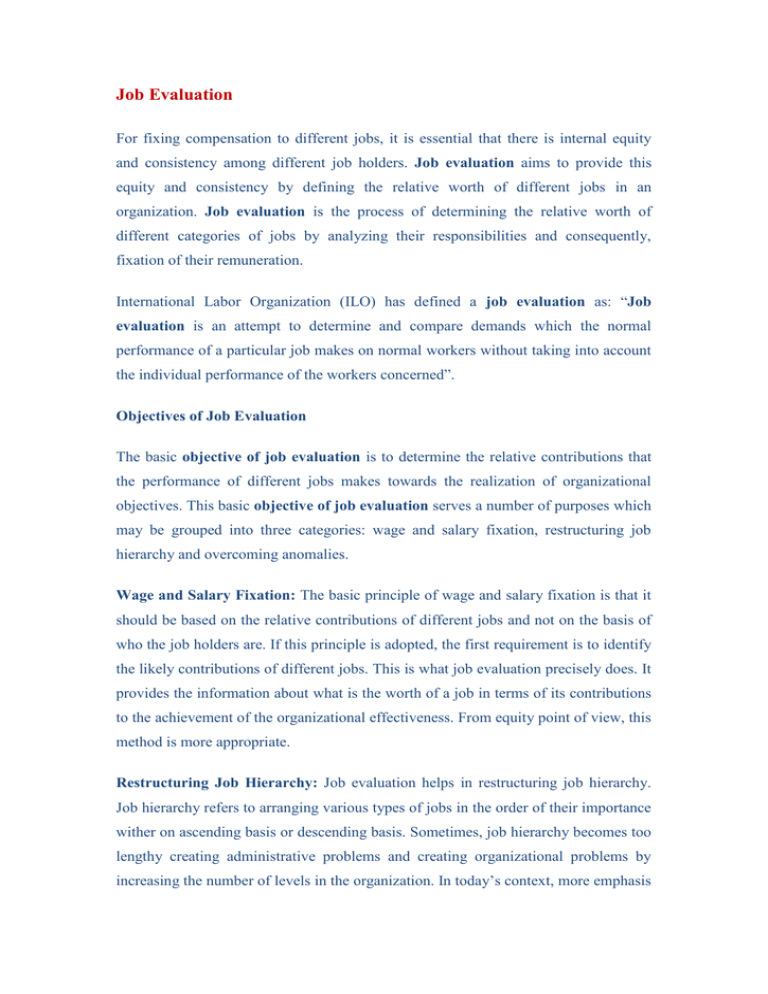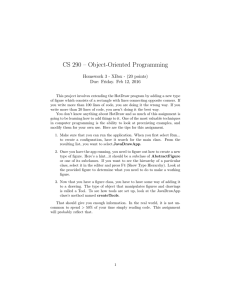Job Evaluation
advertisement

Job Evaluation For fixing compensation to different jobs, it is essential that there is internal equity and consistency among different job holders. Job evaluation aims to provide this equity and consistency by defining the relative worth of different jobs in an organization. Job evaluation is the process of determining the relative worth of different categories of jobs by analyzing their responsibilities and consequently, fixation of their remuneration. International Labor Organization (ILO) has defined a job evaluation as: “Job evaluation is an attempt to determine and compare demands which the normal performance of a particular job makes on normal workers without taking into account the individual performance of the workers concerned”. Objectives of Job Evaluation The basic objective of job evaluation is to determine the relative contributions that the performance of different jobs makes towards the realization of organizational objectives. This basic objective of job evaluation serves a number of purposes which may be grouped into three categories: wage and salary fixation, restructuring job hierarchy and overcoming anomalies. Wage and Salary Fixation: The basic principle of wage and salary fixation is that it should be based on the relative contributions of different jobs and not on the basis of who the job holders are. If this principle is adopted, the first requirement is to identify the likely contributions of different jobs. This is what job evaluation precisely does. It provides the information about what is the worth of a job in terms of its contributions to the achievement of the organizational effectiveness. From equity point of view, this method is more appropriate. Restructuring Job Hierarchy: Job evaluation helps in restructuring job hierarchy. Job hierarchy refers to arranging various types of jobs in the order of their importance wither on ascending basis or descending basis. Sometimes, job hierarchy becomes too lengthy creating administrative problems and creating organizational problems by increasing the number of levels in the organization. In today’s context, more emphasis is being put on flat structure instead of tall one. Job evaluation exercise can be undertaken to reduce the number of job levels by merging closely related jobs together. Overcoming Anomalies: Job evaluation, if carried on periodically and objectively, helps in overcoming various anomalies which may develop in an organization over the period of time with regard to compensation management. Knowles and Thompson have identified that there are following anomalies and evils which may develop in an organization and may be overcome by job evaluation. 1. Payment of high wages and salaries to persons who hold jobs and positions not requiring great skill, effort and responsibility; 2. Paying beginners less than that they are entitled to receive in terms of what is required of them; 3. Giving a raise to persons whose performance does not justify the raise; 4. Deciding rates of pay on the basis of seniority rather than ability; 5. Payment of widely varied wages and salaries for the same or closely related jobs and positions; and 6. Payment of unequal wages and salaries on the basis of race, sex, religion, or political differences. Problems in Job Evaluation Like any other technique of human resource management, job evaluation is not free from certain shortcomings and limitations. Various problems involved in job evaluation may be grouped into two categories: technical and operational. Technical Problems: There are some technical problems involved in effective job evaluation, which are of the following nature. 1. Job evaluation establishes hierarchy of jobs based on their worth. Though there are various methods developed for this purpose, these are not completely objective. For example, often the question is asked: ‘Should grass-cutters (gardeners) get more than gas-cutters (welders)’? Similar such questions may be raised if there is lack of objectivity. 2. Another problem in establishing job hierarchy through job evaluation comes in the form of changing profile of job factors because of changes in environmental variables such as technology, social structure and processes, and international impact. Therefore, a job hierarchy, which may be workable at one point of time, may not work at another point of time. Thus, in order to make job evaluation effective, it should be undertaken at regular intervals. 3. Job evaluation is a costly and technical exercise. Therefore, many organizations do not prefer to take it in a formal way. Rather, they prefer to go through prevailing practices. Operational Problems: Besides the technical problems, there are some operational problems too in job evaluation. These are of the following types: 1. Linking jobs, based on job evaluation, and wages and salaries is not completely possible because of the operation of several forces in the environment. There are substantial differences between job factors and the factors emphasized by the human resource market. Often it has been observed that these external factors change with the time, e.g., previously, engineers were the highest earners but now the sequence is followed by medicos, MBAs and now information technology professionals in ascending order through over the period of time, their job factors have remained the same. 2. Job hierarchy created through job evaluation may create human problems in an organization particularly if it has been taken for the first time and results into fundamental differences as compared to the existing system. In such a situation, job evaluation may face resistance from the employees. 3. Job evaluation is, generally, suited to large organizations where human resource management system has been formalized. In comparatively smaller organizations, this may not result in much advantages. The existence of various problems in job evaluation does not mean that it should not be undertaken. In fact, this should be undertaken. The problems identified above indicate that suitable safeguards should be provided while undertaking job evaluation to make it more productive. Source: Compensation management Notes-MGU



